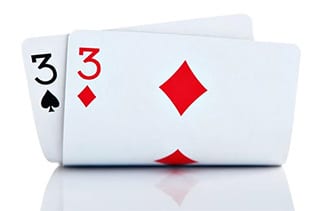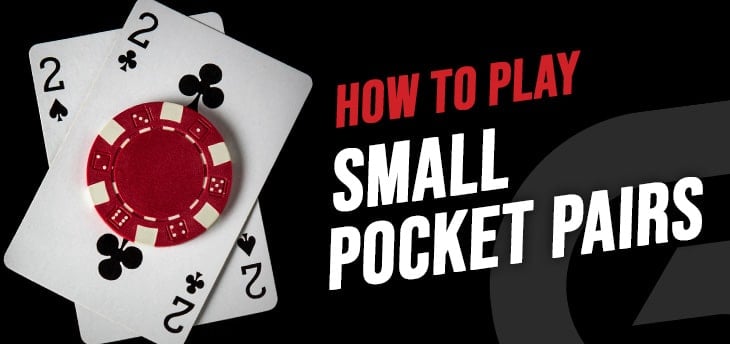Small pocket pairs are one of my favorite hand groups in Texas Hold’em. They tend to be one of the easiest hand groups to play and are usually inexpensive to play. A small pocket pair is generally considered to be any pair between deuce and six and they all play similarly, for the most part. While keeping a few key concepts in mind, it is possible to make small pocket pairs largely profitable utilizing some relatively simple strategies.
Set Mining
“Set mining” refers to investing as little money as possible preflop when you have a small pocket pair in the hopes of flopping a set. Then, when you hit the set, maximize your return by betting hard after the flop. In a typical cash game or early stage of a tournament when stacks are deep (100 big blinds or more), most of the value gained from small pocket pairs comes from their ability to flop sets.
There are generally two schools of thought when you are first to open the action with a small pocket pair. The first is to open limp – the action when the first player to enter the flop calls the blinds instead of raising – in the hopes of encouraging other players to limp behind with marginal holdings. This keeps your preflop investment to a minimum and encourages multiway action so in the case where you do flop a set, you are more likely to get action. The second (and the way I prefer) strategy is to open raise from middle position or later and simply fold in early position. By raising instead of limping, you can keep your range “uncapped” (as you would play your best starting hands the same way) and take initiative. When you are called, the pot will be larger than if you had limped, which makes building a large pot easier post flop when you happen to flop a set. And in the situations where everyone folds, winning the blinds is never a bad thing! Having said that, if your opponents are inexperienced, play too many hands, and/or not paying attention, a limping strategy may well yield the best results.

If you face a raise with a small pocket pair, your strategy should depend on the stack size of the raiser. As a general rule, you should not call a raise with a small pocket pair unless both you and the raiser have at least 10x as many chips behind. For example, in a $1/$2 cash game, if you face a raise of $10, you would want your opponent to have at least $100 behind in their stack. By doing this, you help ensure that you can earn enough profit from your opponent if you hit a set to make up for the times when you don’t hit and are forced to fold. The odds of flopping a set are about 7.5-to-1, so it is important to get paid off handsomely when you find that elusive set.
If one or more players have already limped ahead of you, you should limp along with them. Isolating a limper by raising it with a small pocket pair leads to tricky post flop spots when you don’t flop a set. This aggressive action also discourages what would likely have turned into a cheap multiway pot had you just limped.

Short-Stacked Play
The value of small pocket pairs is considerably reduced when stacks are middling (between 30-40 big blinds) because they often won’t be able to ‘set mine’ profitably and are tricky to play post flop. However, when stacks become short (20 big blinds or fewer), small pocket pairs regain their value because of their ability to fold under pressure or force other players to fold. In these situations, the small pairs can realize their maximum equity by going all-in preflop.
The ability to go all-in profitably with small pocket pairs when short-stacked makes them straightforward and easy to play. With 20 big blinds in an unopened pot, all the small pocket pairs can be shoved profitably from the button or small blind. Your positional requirement goes down the shorter your stack becomes. For example, pocket deuces can be profitably shoved for 10 big blinds from the hijack position or later.
Small pocket pairs can also shove all-in profitably over an initial raiser who figures to have a wide range, such as a late-position raiser. By shoving a short stack over a raise instead of calling, you both maximize the fold equity and fully realize your hand’s equity when called. Imagine a scenario where the button raises and you call from the big blind with 22 with 20 big blinds. The flop comes K95, you check, your opponent bets, and you fold. The problem with this situation is that you’re left guessing when you fail to flop a set. In this scenario, your opponent could easily have an inferior hand like JT or 67 – which are both hands that may have folded had you shoved preflop. And even if called, you are unable to be bluffed post flop as all of your chips are already in the pot. The ranges and stack-depths that can be shoved profitably preflop can be observed and studied using any of a variety of poker software such as SnapShove, which features pre-solved shoving and calling solutions when short-stacked.

